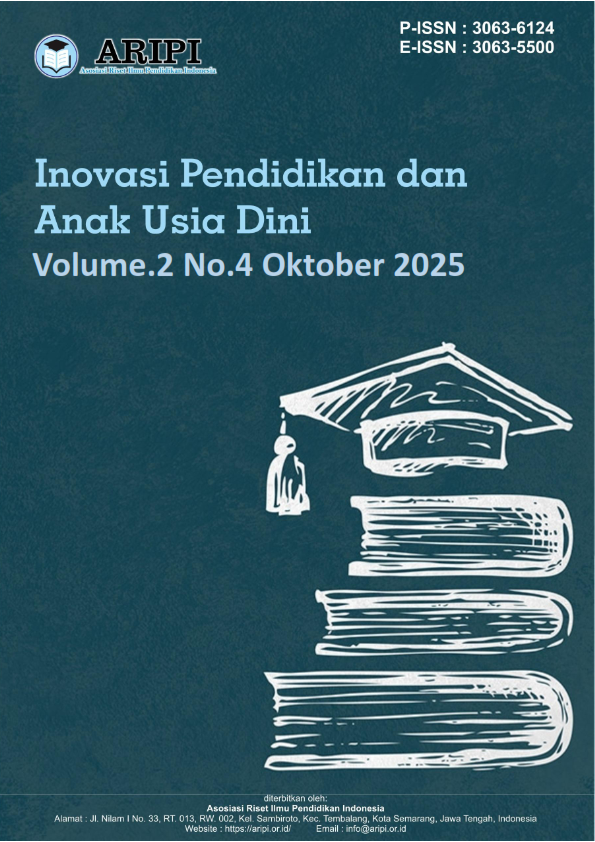Persepsi Guru terhadap Pentingnya Bahasa Indonesia dalam Pengembangan Komunikasi Anak Usia Dini
DOI:
https://doi.org/10.61132/inpaud.v2i4.685Keywords:
Communication Development, Early Childhood, Indonesian Language, Language Learning, Teacher PerceptionAbstract
This study explores teachers’ perceptions of the importance of the Indonesian language in developing communication skills among early childhood learners. As a national language and medium of unity, Indonesian plays a strategic role in children’s linguistic and social growth. The research applied a qualitative descriptive design, using interviews, observations, and documentation with teachers at TK Ar-Raudah in Banjar Regency. Findings reveal that teachers perceive Indonesian as a crucial foundation for enhancing children’s speaking, comprehension, and expressive abilities. The language also supports children’s confidence and social interaction in learning contexts. However, challenges remain, such as the dominance of regional languages and limited teaching resources. Teachers employ strategies combining local and Indonesian languages to build comprehension and comfort. The study concludes that systematic use of Indonesian from early childhood fosters better communication competence and strengthens national identity. Enhancing teacher training and parental involvement is recommended to optimize Indonesian language development in early childhood education.
References
Amalia, W. O. S., & Nurlina. (2023). Strategi guru untuk meningkatkan perkembangan bahasa anak usia dini melalui aktivitas bermain. Ulil Albab, 2(2), 71–77.
Bandura, A. (1986). Social foundations of thought and action: A social cognitive theory. Prentice Hall.
Brown, H. D. (2007). Principles of language learning and teaching. Pearson Education.
Chomsky, N. (1955). The logical structure of linguistic theory. MIT.
Cummins, J. (2000). Language, power and pedagogy: Bilingual children in the crossfire. Multilingual Matters.
Gregory, R. L. (1970). The intelligent eye. Weidenfeld & Nicolson.
Harley, T. A. (2020). The psychology of language. Psychology Press.
Jurnal Cakrawala Pendidikan, 40(3), 455–468.
Kemendikbud (2020). Kurikulum PAUD. Direktorat Jenderal PAUD.
Krashen, S. D. (1982). Principles and practice in second language acquisition. Pergamon.
Miles, M. B., Huberman, A. M., & Saldaña, J. (2014). Qualitative data analysis. Sage Publications.
Piaget, J. (1952). The origins of intelligence in children. International Universities Press.
Sari, D. K., & Rasyimah. (2022). Neurolinguistik: Teori linguistik dan pemerolehan bahasa pada anak. Bahastra, 6(1), 26–34.
Skinner, B. F. (1957). Verbal behavior. Appleton-Century-Crofts.
Tarigan, H. G. (2019). Berbicara sebagai suatu keterampilan berbahasa. Angkasa.
Tobing, H. K., et al. (2024). Strategi komunikasi efektif dalam pendidikan anak usia dini. Jurnal Global Ilmiah, 1(10), 355–359.
Vygotsky, L. S. (1978). Mind in society. Harvard University Press.
Wulandari, N., & Rahman, A. (2021). Implementasi bilingualisme di PAUD Indonesia.
Yuliana, D., & Sutopo, A. (2020). Penggunaan bahasa Indonesia pada anak prasekolah. Jurnal Pendidikan Anak Usia Dini, 8(2), 112–120.
Zaini, F. (2021). Peran guru dalam pemerolehan bahasa anak. Jurnal Ilmu Pendidikan, 5(4), 299–310.
Zulfikar, R., & Hidayat, S. (2022). Strategi peningkatan literasi bahasa pada anak usia dini. Jurnal Literasi Pendidikan, 3(1), 44–52.









